译林牛津七年级上学期英语语法规则总结
- 格式:docx
- 大小:37.07 KB
- 文档页数:5
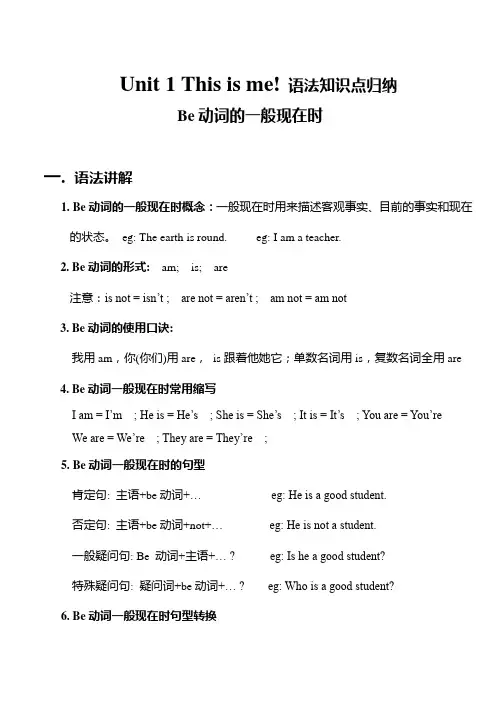
Unit 1 This is me!语法知识点归纳Be动词的一般现在时一. 语法讲解1. Be动词的一般现在时概念:一般现在时用来描述客观事实、目前的事实和现在的状态。
eg: The earth is round. eg: I am a teacher.2. Be动词的形式: am; is; are注意:is not = isn’t ; are not = aren’t ; am not = am not3. Be动词的使用口诀:我用am,你(你们)用are,is跟着他她它;单数名词用is,复数名词全用are4. Be动词一般现在时常用缩写I am = I’m ; He is = He’s ; She is = She’s ; It is = It’s ; You are = You’reWe are = We’re ; They are = They’re ;5. Be动词一般现在时的句型肯定句: 主语+be动词+… eg: He is a good student.否定句: 主语+be动词+not+… eg: He is not a student.一般疑问句: Be 动词+主语+… ? eg: Is he a good student?特殊疑问句: 疑问词+be动词+… ? eg: Who is a good student?6. Be动词一般现在时句型转换Be动词一般现在时肯定句变否定句规则:在be动词后加not, 即在am, is, are 后直接加not。
eg: They are doctors. 否定句为:They are not doctors.Be动词一般现在时肯定句变一般疑问句规则:be动词提到句首,即将am, is, are 提到句首。
eg: They are doctors. 一般疑问句为:Are they doctors?7. 注意:肯定句中如果有I, we 在变一般疑问句时,要统一变为you,译为:你/你们肯定句中如果有my, our 在变一般疑问句时,要统一变为your,译为:你的/你们的二. 专项练习I.用be动词的适当形式填空(40*2=80’)1. My brother’s birthday ____ on D ecember 11th.2. My brother with his friends _____ in the room.3. Amy and Simon _____ in the classroom.4. Maths ___ his favourite subject.5. Tom and Daniel ___ from England.6. _____ your friend in Class 17, Grade 7?7. _____ your sister and Millie in the same class?8. _____ her brother good at English?9. _____ this your father’s car?10. Here _____ some flowers for you.11. I ______ a boy. ______ you a boy? No, I _____ not.12. The dog _______ big and fat.13. Her clothes _____ over there.14. Whose socks ____ they?15. This pair of glasses ____ for Yang Ling.16. The two cups of milk ____ for me.17. Some tea ______ in the glass.18. My sister's name ______Nancy.19. _______ there any apple juice in the bottle?20. You, he and I ____ from China.21. --- How___ you? ---I ____ fine.22. I ___ David, and my family name ___ Green.23. ---What color ___ your iphone? ---It___ white.24. ---What ___ this in English? ---It___ an apple.25. James ___ my brother. David ___my brother, too. They ___ my brothers.26. Look! These____ apple trees.27. We____ good students and you____ a good teacher.28. Five and three ____ eight.29. ____ your phone number 123456?30. Where_____ your pencils?31. How much ____ his jacket?II.句型转换(10*1=10’)1. My name is Millie. (改为同义句)______ ______ Millie.2. I am a clever boy. (改为一般疑问句)______ ______ a clever boy?3. Our pens are red. (改为一般疑问句)______ ______ pens red?4. Are the boys from Xinxiang? (作否定回答)No, _______ _______.5. We are in Grade Seven. (改为否定句)______ _______ in Grade Seven.III.在下列短文中填入适当的be动词(10*1=10’)I ______ a girl. My name _______ Mary. I ______ in Class 17, Grade 7. I ______12 years old. Here ______ my family photo. Look! These ______ my parents and those _______ my grandparents. This boy ______ my brother. He ________ 15 years old now. That ______ my cat, Mimi. It ______ very lovely(可爱的).。
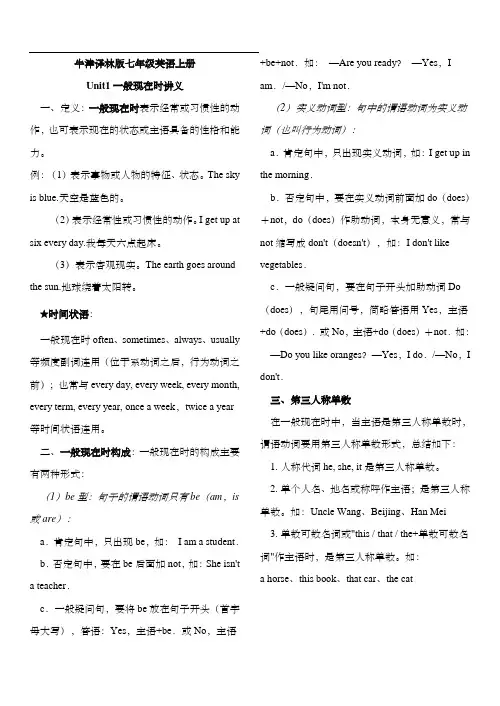
牛津译林版七年级英语上册Unit1一般现在时讲义一、定义:一般现在时表示经常或习惯性的动作,也可表示现在的状态或主语具备的性格和能力。
例:(1)表示事物或人物的特征、状态。
The sky is blue.天空是蓝色的。
(2)表示经常性或习惯性的动作。
I get up at six every day.我每天六点起床。
(3)表示客观现实。
The earth goes around the sun.地球绕着太阳转。
★时间状语:一般现在时often、sometimes、always、usually 等频度副词连用(位于系动词之后,行为动词之前);也常与every day, every week, every month, every term, every year, once a week,twice a year 等时间状语连用。
二、一般现在时构成:一般现在时的构成主要有两种形式:(1)be型:句子的谓语动词只有be(am,is 或are):a.肯定句中,只出现be,如:I am a student.b.否定句中,要在be后面加not,如:She isn't a teacher.c.一般疑问句,要将be放在句子开头(首字母大写),答语:Yes,主语+be.或No,主语+be+not.如:—Are you ready?—Yes,I am./—No,I'm not.(2)实义动词型:句中的谓语动词为实义动词(也叫行为动词):a.肯定句中,只出现实义动词,如:I get up in the morning.b.否定句中,要在实义动词前面加do(does)+not,do(does)作助动词,本身无意义,常与not缩写成don't(doesn't),如:I don't like vegetables.c.一般疑问句,要在句子开头加助动词Do (does),句尾用问号,简略答语用Yes,主语+do(does).或No,主语+do(does)+not.如:—Do you like oranges?—Yes,I do./—No,I don't.三、第三人称单数在一般现在时中,当主语是第三人称单数时,谓语动词要用第三人称单数形式,总结如下:1.人称代词he, she, it是第三人称单数。
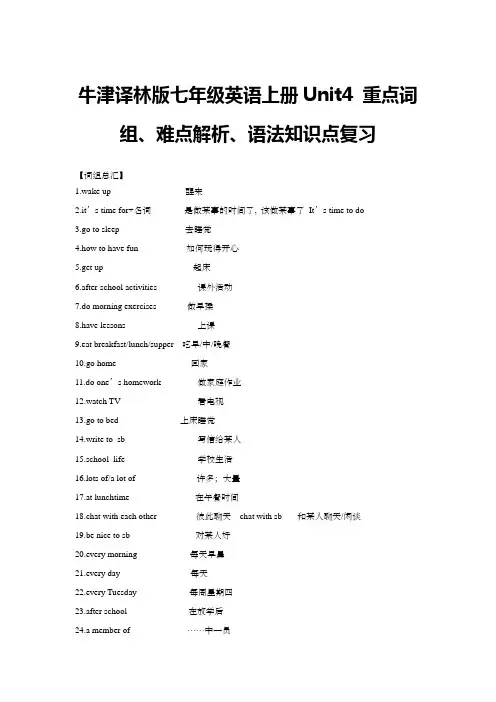
牛津译林版七年级英语上册Unit4 重点词组、难点解析、语法知识点复习【词组总汇】1.wake up 醒来2.it’s time for+名词是做某事的时间了, 该做某事了It’s time to do3.go to sleep 去睡觉4.how to have fun 如何玩得开心5.get up 起床6.after-school activities 课外活动7.do morning exercises 做早操8.have lessons 上课9.eat breakfast/lunch/supper 吃早/中/晚餐10.go home 回家11.do one’s homework 做家庭作业12.watch TV 看电视13.go to bed 上床睡觉14.write to sb 写信给某人15.school life 学校生活16.lots of/a lot of 许多;大量17.at lunchtime 在午餐时间18.chat with each other 彼此聊天chat with sb 和某人聊天/闲谈19.be nice to sb 对某人好20.every morning 每天早晨21.every day 每天22.every Tuesday 每周星期四23.after school 在放学后24.a member of ……中一员25.the Swimming Club 游泳兴趣小组26.have a good time 玩的开心27.email sb 给某人发电子邮件28.play games 玩游戏, 进行比赛29.twice a week 一周两次30.have fun 娱乐,乐趣;开心P.27-3031.listen to the radio 听收音机32.make a model plane 制作模型飞机33.read newspapers 看报read books 看书34.write emails 写邮件35.watch football matches 看球赛36.watch too much TV 看电视太多37.listen to music 听音乐38.listen to the teacher 听老师讲39.walk a dog 遛狗40.a piece of good news 一则好消息41.in the school football team 在学校足球队42.all the time 一直43.know (a lot) about…对……了解(很多)44.read comic books 看连环漫画书45.on the volleyball court 在排球场46.from...to…从……到……47.meet up with sb. 约见某人48.do their homework 做他们的作业49.under a big tree 在大树下50.go to one’s dancing lesson 去上舞蹈课51.have (no) time to do sth. 有(没有)时间做某事52.have a lot of new friends 有许多新朋友53.teach us English 教我们英语54.talk about…谈论关于……55.at home 在家56.say hello to…向……问好P.31-3757.the Class 1,Grade 7 students 七年级一班学生58.go on a trip 旅行, 旅游have one’s trip59.look at the posters 看海报60.more than 多于;超过61.twice a week 一星期两次62.the China Space Museum 中国航空博物馆63.the China Science and Technology Museum 中国科技博物馆64.next Monday 下周一65.each student 每个学生66.thank you for doing sth 为做某事而谢谢你anize the class trip 组织班级旅游68.I would like to+动词原形愿意干某事;想要干某事69.the price for………的价格70.be open/be closed 开着、关着71.look forward to…期盼;盼望72.enjoy…very much 非常喜爱……73.need to do sth 需要做……74.borrow a pen 借一支钢笔75.be busy doing 忙于做某事76.be good for 有益于77.help sb do sth 帮助某人做某事78.get ready for 准备……79.learn more about 更多了解……80.the answer to ………的答案81.the Computer Club 电脑兴趣小组【难点解析】1.Is it time for breakfast? 是吃早餐的时间了吗?it’s time for+名词, “是做某事的时间了, 该做某事了”=it’s time to+动词原形.例如:It’s time for class.是上课的时间了。
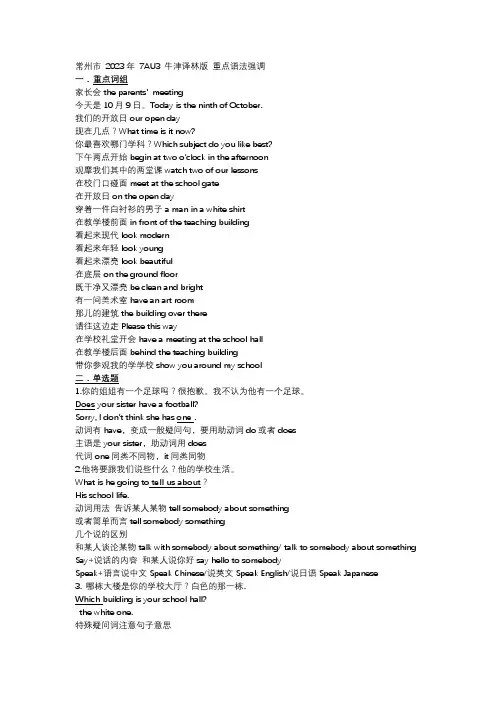
常州市2023年7AU3 牛津译林版重点语法强调一.重点词组家长会the parents’meeting今天是10月9日。
Today is the ninth of October.我们的开放日our open day现在几点?What time is it now?你最喜欢哪门学科?Which subject do you like best?下午两点开始begin at two o'clock in the afternoon观摩我们其中的两堂课watch two of our lessons在校门口碰面meet at the school gate在开放日on the open day穿着一件白衬衫的男子a man in a white shirt在教学楼前面in front of the teaching building看起来现代look modern看起来年轻look young看起来漂亮look beautiful在底层on the ground floor既干净又漂亮be clean and bright有一间美术室have an art room那儿的建筑the building over there请往这边走Please this way在学校礼堂开会have a meeting at the school hall在教学楼后面behind the teaching building带你参观我的学学校show you around my school二.单选题1.你的姐姐有一个足球吗?很抱歉。
我不认为他有一个足球。
Does your sister have a football?Sorry, I don't think she has one .动词有have,变成一般疑问句,要用助动词do或者does主语是your sister,助动词用does代词one同类不同物,it同类同物2.他将要跟我们说些什么?他的学校生活。
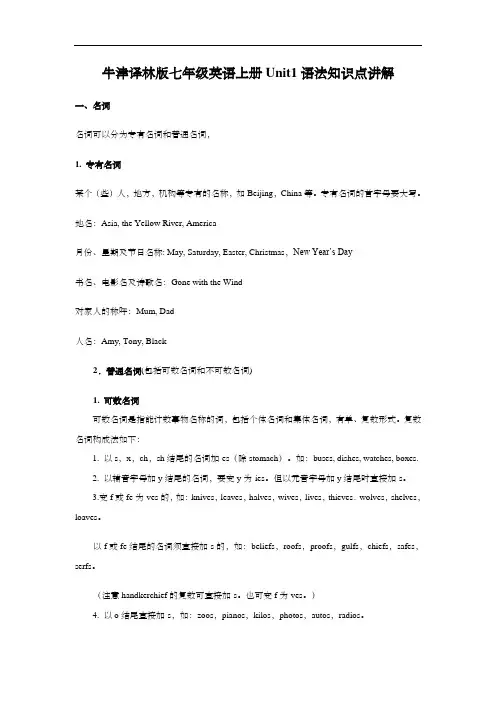
牛津译林版七年级英语上册Unit1语法知识点讲解一、名词名词可以分为专有名词和普通名词,1. 专有名词某个(些)人,地方,机构等专有的名称,如Beijing,China等。
专有名词的首字母要大写。
地名:Asia, the Yellow River, America月份、星期及节日名称: May, Saturday, Easter, Christmas,New Year’s Day书名、电影名及诗歌名:Gone with the Wind对家人的称呼:Mum, Dad人名:Amy, Tony, Black2.普通名词(包括可数名词和不可数名词)1. 可数名词可数名词是指能计数事物名称的词,包括个体名词和集体名词,有单、复数形式。
复数名词构成法如下:1. 以s,x,ch,sh结尾的名词加-es(除stomach)。
如:buses, dishes, watches, boxes.2. 以辅音字母加y结尾的名词,要变y为-ies。
但以元音字母加y结尾时直接加-s。
3.变f或fe为-ves的,如:knives,leaves,halves,wives,lives,thieves.wolves,shelves,loaves。
以f或fe结尾的名词须直接加-s的,如:beliefs,roofs,proofs,gulfs,chiefs,safes,serfs。
(注意handkerchief的复数可直接加-s。
也可变f为-ves。
)4. 以o结尾直接加-s,如:zoos,pianos,kilos,photos,autos,radios。
加-es,如:Negroes,heroes,potatoes,tomatoes。
(有生命的加es, 无生命的加s, 注意植物是有生命的)复数不规则的名词名词复数的不规则变化1)变内部元音。
如foot—feet tooth—teeth man—men woman—women由一个词加man 或woman构成的合成词,其复数形式也是-men 和-women,如an Englishman,two Englishmen。

Unit 7一.情态动词Can的用法A.表示能力表示现在的能力用can,表示过去的能力用could例如:I couldn’t swim at the age of 7,but now I can.I couldn’t read books when I was a child, now I can.B.表示许可,征求意见(Can, could, may)①Can用于一般情况例子:Can you bring a book to me ?②could 用于更加委婉的情况例子:Could I have a rest teacher?③may用于更加正式的情况(陌生人)例子:May I e in?注意:做题时can/could/may 没有明确的区别重点:can/could/may的一般疑问句Can I.....? Yes,you can. No, you can’tCould I....? Yes, you can. No, you can’tMay I...? Yes, you may/can. No,you can’t/may not.二.感叹句A.What的感叹句What+adj+n+(主+谓)What+_____a/an+adj+n_______(+主语+谓语)!What+______adj+复数n________(+主语+谓语)!What+_____adj+不可数n_________(+主语+谓语)!例子:What a lovely girl (she is)! What an interesting book (it is )! What colourful pencils (they are)! What delicious bread (it is )!B.How的感叹句How +adj/adv+the+n+(主+谓)例子:How lovely (the girl is) ! How interesting( the book is)! How colourful (the pencils are)! How delicious (the bread is)!总结:what+的是名词how+的是形容词/副词练习:一、用can, can’t, could, couldn’t或may填空1. —________ you play basketball? —No, I ________ , but I ________ play football.2. —________ I use your new bike? —Of course you may.3. —________ Bill Gates use a puter when he was three years old? —No, he ________ .4. It will be warm tomorrow so we ________ wear dresses.5. —________ I borrow some money from you? —Sorry, you ________ . I don’t have any.6. Jack ________ pass this Maths exam, because he never works hard.7. Mrs Green bought a new car last month, so she ________ drive to work now.二、用what, what a, what an或how填空1. ________ fine day it was yesterday!2. ________ important work she is doing!3. ________ useful book it is!4. ________ interesting story our g teacher told us yesterday!5. ________ wonderful the music is!6. ________ great fun they had last night!7. ________ well the girl is playing the piano!8. ________ hard they are working in the field!2. ___________ fast he is swimming in the pool!A. How aB. What aC. WhatD. How3. Could you go to the bookshop with me?Sorry, I ___________. I have to finish my homework.A. can'tB. couldn’tC. needn'tD. mustn’t4. V olunteers (志愿者) from Lantian Team saved many travelers in the mountains.___________ they are!A. How great a manB. How great menC. What a great menD. What great men5. They ___________ go cycling yesterday, because the rain was too heavy.A. couldn'tB. can'tC. may notD. don’t6. You ___________ take me to the station. My brother is taking meA. can'tB. mustn’tC. shouldn'tD. don't have to7. When Jessica was young, she ___________ able to dance very well.A. can beB. might beC. could beD. was8. ___________ the children are having now!A. What a good timeB. What good timeC. How good timeD. How a good time9. Dad, ___________ I visit the Modern Art Museum next Monday?I'm afraid you can't. All the museums in this city are closed on Monday.A. wouldB. needC. shouldD. may。
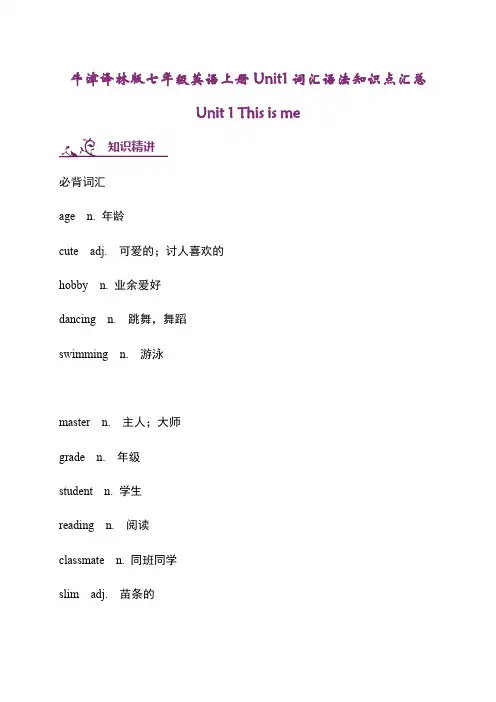
牛津译林版七年级英语上册Unit1词汇语法知识点汇总Unit 1 This is me知识精讲必背词汇age n. 年龄cute adj. 可爱的;讨人喜欢的hobby n. 业余爱好dancing n. 跳舞,舞蹈swimming n. 游泳master n. 主人;大师grade n. 年级student n. 学生reading n. 阅读classmate n. 同班同学slim adj. 苗条的over 在……上classroom n. 教室二、重点词汇1. master noun & verb /ˈmɑːstər/1). n. a person who is very skilled in a particular job or activity大师,名家;专家例句:He was a master of disguise.他是个伪装大师。
This painting is clearly the work of a master.这幅画显然是名家的作品。
2). v. to learn how to do something well精通,掌握例句:She lived in Italy for several years but never quite mastered the language. 她在意大利住了好几年,但一直没怎么学好意大利语。
He quickly mastered the art of interviewing people.他很快就掌握了采访的艺术。
2. member noun /ˈmembər/1). a person, animal, or thing that is part of a group成员,一分子例句:The lion is a member of the cat family.狮子是猫科动物。
Representatives of the member states will be meeting next week.成员国代表将于下周会晤。
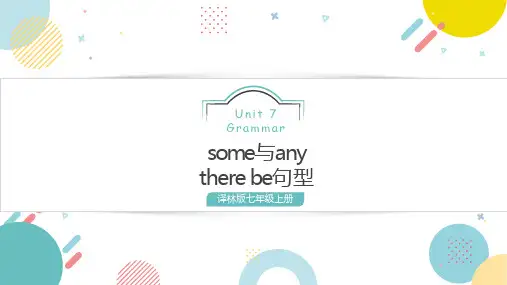
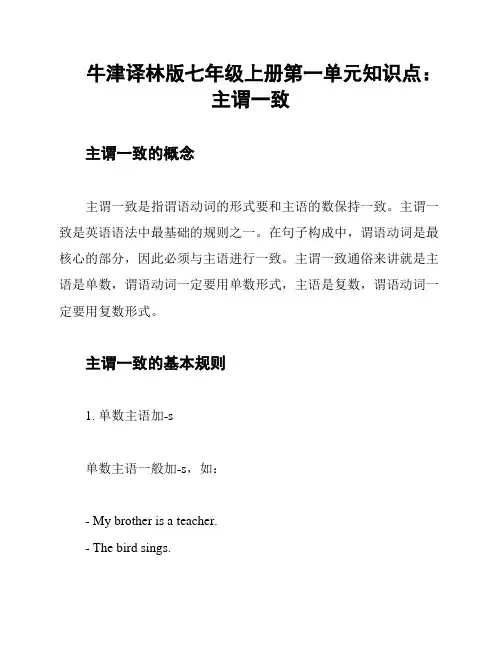
牛津译林版七年级上册第一单元知识点:主谓一致主谓一致的概念主谓一致是指谓语动词的形式要和主语的数保持一致。
主谓一致是英语语法中最基础的规则之一。
在句子构成中,谓语动词是最核心的部分,因此必须与主语进行一致。
主谓一致通俗来讲就是主语是单数,谓语动词一定要用单数形式,主语是复数,谓语动词一定要用复数形式。
主谓一致的基本规则1. 单数主语加-s单数主语一般加-s,如:- My brother is a teacher.- The bird sings.2. 复数主语不加-s复数主语一般不加-s,如:- My brothers are teachers.- The birds sing.3. 以s、x、ch,sh结尾的单词加-es如:- Tom watches TV every day.- The box is on the table.- She teaches French.4. 单数主语以y结尾,去y加-ies如:- My family usually eats sandwiches for lunch.- The baby cries all night.5. 有些名词只用单数形式如:- water,air,bread 等。
6. 由and连接的两个主语如果and连接的是两个单数主语,谓语动词要用复数形式;如果and连接的是一个单数主语和一个复数主语,谓语动词要用复数形式,如:- My father and mother are both teachers.- The cat and the dog fight for the meat.练1. The boy ____(play) soccer with his friends after school every day.2. The students in our class ____(listen) carefully to the teacher in class.3. The little girl ___ (cry) when she watches a sad film.4. The dog and the cat ____ (fight) for the meat.5. The cake on the table ___ (smell) delicious.小结主谓一致是英语语法中最基础的规则之一,也是学习英语语法的基础。

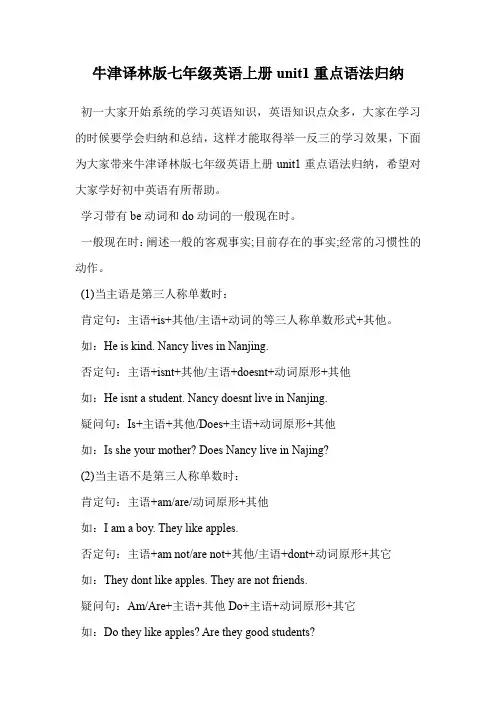
牛津译林版七年级英语上册unit1重点语法归纳初一大家开始系统的学习英语知识,英语知识点众多,大家在学习的时候要学会归纳和总结,这样才能取得举一反三的学习效果,下面为大家带来牛津译林版七年级英语上册unit1重点语法归纳,希望对大家学好初中英语有所帮助。
学习带有be动词和do动词的一般现在时。
一般现在时:阐述一般的客观事实;目前存在的事实;经常的习惯性的动作。
(1)当主语是第三人称单数时:肯定句:主语+is+其他/主语+动词的等三人称单数形式+其他。
如:He is kind. Nancy lives in Nanjing.否定句:主语+isnt+其他/主语+doesnt+动词原形+其他如:He isnt a student. Nancy doesnt live in Nanjing.疑问句:Is+主语+其他/Does+主语+动词原形+其他如:Is she your mother? Does Nancy live in Najing?(2)当主语不是第三人称单数时:肯定句:主语+am/are/动词原形+其他如:I am a boy. They like apples.否定句:主语+am not/are not+其他/主语+dont+动词原形+其它如:They dont like apples. They are not friends.疑问句:Am/Are+主语+其他Do+主语+动词原形+其它如:Do they like apples? Are they good students?牛津译林版七年级英语上册unit1重点语法归纳为大家带来过了,英语的学习重在掌握知识点,希望大家能够熟练掌握上面的内容,这样大家的英语成绩就能迅速提升。
牛津译林版七年级英语上册Unit7语法知识点汇总PartI 、some 与anysome意为“一些”、“几个”,通常用于肯定句中。
现将其主要用法归纳如下:一、some作形容词用时,可以修饰复数可数名词,也可以修饰不可数名词。
例如: There are _________ students in the classroom. 教室里有几个学生。
There ______ some milk in the glass. 杯子里有一些牛奶。
二、some作代词用时,可在句中作主语或宾语。
例如: Some of the boys _______ playing games now. 有几个男孩现在正在做游戏。
I have no paper. Please give me __________. 我没有纸了,请给我一些吧。
三、some有时也可以用在疑问句中,表示请求、建议,并期望得到对方的肯定回答。
它也可以用于反问句中。
例如: Can you give me________ money? 你能给我一些钱吗? Would you like________ more rice? 再来点米饭好吗? Why don’t you buy __________ flowers for her? 你为什么不给她买些花呢?any也有“一些”的意思,但它常用在否定句、否定答语或疑问句中。
其具体用法如下:一、any作形容词用时,可以修饰可数名词的单数或复数,也可以修饰不可数名词。
例如: Do you have________ questions to ask? 你有什么问题要问吗? There isn’t ________ water in this bottle. 这个瓶子里没有水。
二、any作代词用时,也可用于肯定句中,表示“任何”的意思,起强调作用。
例如: You may take _______ of them. 这些东西,你随便拿哪个都行。
译林剑桥七年级上学期英语语法总结本文档旨在总结译林剑桥七年级上学期英语语法知识点,并为学生提供一个简洁的复参考。
一、词类1. 名词(Noun):指示人、事物、地方或概念的名称,如dog (狗)、book(书)等。
名词可以分为可数名词和不可数名词。
2. 代词(Pronoun):用于代替名词或名词短语,如he(他)、this(这个)等。
代词可以分为人称代词、物主代词、指示代词等。
3. 形容词(Adjective):用于描述名词的性质、特征或状态,如beautiful(漂亮的)、big(大的)等。
4. 副词(Adverb):用于修饰动词、形容词或其他副词,表示程度、方式、时间等,如quickly(快速地)、often(经常)等。
5. 动词(Verb):表示动作、状态或存在,如run(跑)、play(玩)等。
动词可以分为及物动词和不及物动词。
6. 介词(Preposition):用于表达时间、地点、方向等关系,如in(在)、on(在上面)等。
7. 连词(Conjunction):用于连接句子、词或词组,如and (和)、but(但是)等。
8. 冠词(Article):用于限定名词的范围,分为定冠词a/an和不定冠词the。
9. 数词(Numeral):表示数目的词语,如one(一)、two (二)等。
10. 感叹词(Interjection):表示强烈的情感或感叹的词语,如oh(哦)、wow(哇)等。
二、时态1. 一般现在时(Simple Present):表示经常性或普遍性的动作、状态或事实,如I go to school every day(我每天去学校)。
2. 现在进行时(Present Continuous):表示现在正在进行的动作,如She is reading a book(她正在读书)。
3. 一般过去时(Simple Past):表示过去发生的动作或状态,如He played football yesterday(他昨天踢足球)。
牛津译林版七年级英语上册units1-4单元语法讲解一.一般现在时中be 动词的使用(一)be 动词:动词be (am, is, are)说明身份、年龄、状态等I am a teacher.I am 21 years old.I' m very healthy.(二)be 动词的人称变化:第一人称I,后面的动词用am;第三人称he/she/it, 后面的动词用is;第一人称复数we,第二人称you,第三人称复数they,后面的动词用are.(三)be 动词在一般疑问句和否定句中的表达:--- Are you the student from Class Two?--- No, I'm not.--- Is he Canadian?--- No, he isn' t.--- Are they fond of pop music?--- No, they aren 't.从上面例句中可看出,动词be 一般现在时的一般疑问句,把be 提到句首,它的否定句式是在be 后直接加not 。
(四)be 动词的具体使用:1.be + 形容词I'm very tired.He is handsome and smart.2. be + 名词Mike is a Canadian teacher.They are my close friends.3. be + 介词短语The flowers are in the vase.She is at home now.4. be + 形容词短语My holiday is always long enough.They are tired and hot.5. be +副词I'm home.They are abroad.6. 用于表示时间:Today is Sunday.The next match will be at 7.二•一般现在时中行为动词的使用1. 一般现在时:用于谈论我们经常做的事;目前的状态;目前的爱好、能力;客观事实;真理。
译林牛津七年级上学期英语语法规则总结
本文档总结了译林牛津七年级上学期英语的语法规则。
1. 名词
名词是表示人、动物、事物、地点等具体或抽象概念的词语。
名词在句子中可以作为主语、宾语、定语等。
1.1 单数名词
- 单数名词一般直接使用,例如:book(书)、apple(苹果)。
1.2 复数名词
- 复数名词一般在词尾加上-s或-es,例如:books(书籍)、apples(苹果)。
2. 动词
动词表示动作或状态的词语。
动词在句子中可以作为谓语、宾语、定语等。
2.1 一般现在时
- 一般现在时用于表示经常性或普遍性的行为或状态,例如:I go to school every day(我每天去学校)。
2.2 动词原形
- 动词原形用于表示对某事物的普遍性描述,例如:Water boils at 100 degrees Celsius(水在100摄氏度烧开)。
3. 形容词
形容词用于修饰名词或代词,表示人或事物的性质或特征。
3.1 形容词的比较级
- 形容词的比较级用于比较两个人或事物的差异,例如:She is taller than me(她比我高)。
3.2 形容词的最高级
- 形容词的最高级用于比较三个或更多人或事物的差异,例如:He is the tallest boy in the class(他是班级里最高的男孩)。
4. 副词
副词用于修饰动词、形容词或其他副词,表示时间、地点、方式、程度等。
4.1 副词的用法
- 副词可以修饰动词、形容词或其他副词,例如:She runs quickly(她跑得快)。
5. 介词
介词用于表示人或事物在时间、地点、方式等方面的关系。
5.1 常见介词
- 常见的介词有in(在)、on(在上面)、at(在...处)等,例如:He is studying in the library(他在图书馆研究)。
6. 冠词
冠词用于限定名词。
6.1 定冠词
- 定冠词用于表示特定的、已知的人或事物,例如:The book on the table is mine(桌子上的那本书是我的)。
6.2 不定冠词
- 不定冠词用于表示泛指的人或事物,例如:I have a cat(我有一只猫)。
以上是译林牛津七年级上学期英语语法规则的总结。
---
*注意:本文档内容仅供参考,请以课本或教师指导为准。
*。